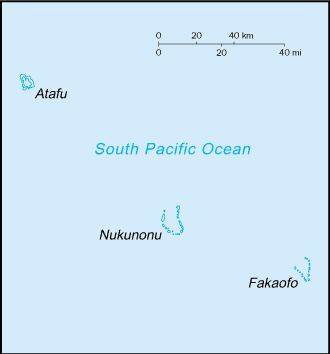|
|
Legend:
 Definition
Definition
 Field Listing
Field Listing
|
Background:
|


Originally settled by Polynesian emigrants from surrounding island groups, the Tokelau Islands were made a British protectorate in 1889. They were transferred to New Zealand administration in 1925.
|
|
Population:
|


1,431 (July 2002 est.)
|
|
Age structure:
|


0-14 years: 42%
15-64 years: 53%
65 years and over: 5% (1996 est.)
|
|
Population growth rate:
|


-0.92% (2002 est.)
|
|
Birth rate:
|


NA births/1,000 population
|
|
Death rate:
|


NA deaths/1,000 population
|
|
Net migration rate:
|


NA migrant(s)/1,000 population
|
|
Sex ratio:
|


NA
|
|
Infant mortality rate:
|


38 deaths/1,000 live births (2002 est.)
|
|
Life expectancy at birth:
|


total population: NA years
male: 68 years (2001)
female: 70 years (2001)
|
|
Total fertility rate:
|


NA children born/woman
|
|
HIV/AIDS - adult prevalence rate:
|


NA%
|
|
HIV/AIDS - people living with HIV/AIDS:
|


NA
|
|
HIV/AIDS - deaths:
|


NA
|
|
Nationality:
|


noun: Tokelauan(s)
adjective: Tokelauan
|
|
Ethnic groups:
|


Polynesian
|
|
Religions:
|


Congregational Christian Church 70%, Roman Catholic 28%, other 2%
note: on Atafu, all Congregational Christian Church of Samoa; on Nukunonu, all Roman Catholic; on Fakaofo, both denominations, with the Congregational Christian Church predominant
|
|
Languages:
|


Tokelauan (a Polynesian language), English
|
|
Literacy:
|


NA
|
|
Economy - overview:
|


Tokelau's small size (three villages), isolation, and lack of resources greatly restrain economic development and confine agriculture to the subsistence level. The people rely heavily on aid from New Zealand - about $4 million annually - to maintain public services, annual aid being substantially greater than GDP. The principal sources of revenue come from sales of copra, postage stamps, souvenir coins, and handicrafts. Money is also remitted to families from relatives in New Zealand.
|
|
GDP:
|


purchasing power parity - $1.5 million (1993 est.)
|
|
GDP - real growth rate:
|


NA%
|
|
GDP - per capita:
|


purchasing power parity - $1,000 (1993 est.)
|
|
GDP - composition by sector:
|


agriculture: NA%
industry: NA%
services: NA%
|
|
Population below poverty line:
|


NA%
|
|
Household income or consumption by percentage share:
|


lowest 10%: NA%
highest 10%: NA%
|
|
Inflation rate (consumer prices):
|


NA%
|
|
Labor force:
|


NA
|
|
Unemployment rate:
|


NA%
|
|
Budget:
|


revenues: $430,830
expenditures: $2.8 million, including capital expenditures of $37,300
|
|
Industries:
|


small-scale enterprises for copra production, woodworking, plaited craft goods; stamps, coins; fishing
|
|
Industrial production growth rate:
|


NA%
|
|
Electricity - production:
|


NA kWh
|
|
Electricity - production by source:
|


fossil fuel: NA%
hydro: NA%
other: NA%
nuclear: NA%
|
|
Electricity - consumption:
|


NA kWh
|
|
Agriculture - products:
|


coconuts, copra, breadfruit, papayas, bananas; pigs, poultry, goats
|
|
Exports:
|


$98,000 f.o.b. (1983)
|
|
Exports - commodities:
|


stamps, copra, handicrafts
|
|
Exports - partners:
|


NZ
|
|
Imports:
|


$323,000 c.i.f. (1983)
|
|
Imports - commodities:
|


foodstuffs, building materials, fuel
|
|
Imports - partners:
|


NZ
|
|
Debt - external:
|


$0
|
|
Economic aid - recipient:
|


from New Zealand about $4 million annually
|
|
Currency:
|


New Zealand dollar (NZD)
|
|
Currency code:
|


NZD
|
|
Exchange rates:
|


New Zealand dollars per US dollar - 2.3535 (January 2002), 2.3776 (2001), 2.1863 (2000), 1.8886 (1999), 1.8632 (1998), 1.5083 (1997)
|
|
Fiscal year:
|


1 April - 31 March
|
|
Military - note:
|


defense is the responsibility of New Zealand
|
|
Disputes - international:
|


none
|
This page was last updated on 19 March 2003
|




